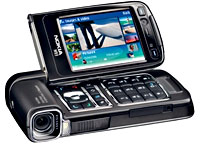 The dome-headed boffins at Nokia have triumphantly put their multiple pens back in their white coat pockets as the new Nokia N73 and N93 phones roll out on the product slipway.
The dome-headed boffins at Nokia have triumphantly put their multiple pens back in their white coat pockets as the new Nokia N73 and N93 phones roll out on the product slipway.
Both phones come with large 2.4″ QVGA displays and high quality, Sony Ericsson-challenging 3 Megapixel cameras (2048 x 1536 pixels), armed with powerful flashes and Carl Zeiss lenses.
There’s also a new Xpress Share client which is designed to make it easy for mobile snappers to blast off their masterpieces via MMS or email, or upload images to Flickr accounts.
Both phones are equipped with S60 3rd Edition operating systems, which comes with Nokia’s new full web browser and a brand spanking new camera interface.
Nokia N73. Amazin’ Raisin Aero Bar.
 Being Brits, we refuse to describe mobiles as having a ‘candybar’ form factor, so how about we call the N73, ‘Amazin’ Raisin Bar’ shaped?
Being Brits, we refuse to describe mobiles as having a ‘candybar’ form factor, so how about we call the N73, ‘Amazin’ Raisin Bar’ shaped?
Too obscure?
Well, we would say Mars Bar shaped, but then some of you with smutty minds might start giggling at the back, so we’ll settle for ‘Chunky Aero Bar’ instead.
Now that that’s settled, we can tell you that the Chunky Aero Bar-shaped N73 is designed to replace the popular N70 model and offers Quadband GSM/EDGE connectivity, with some models also including include 2100 MHz UMTS.
Unleashed from behind its spring-assisted cover, there’s an auto-focus 3.2 megapixel camera boasting Carl Zeiss optics, with 42 MB built-in memory and a MiniSD slot for additional storage.
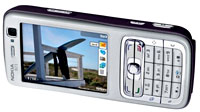 Rounding off the man-sized feature set is Bluetooth 2.0, a music player supporting MP3, AAC, AAC+ and WMA, video player with streaming support, FM radio with visual radio and a set of built-in pixie-sized 3D stereo speakers.
Rounding off the man-sized feature set is Bluetooth 2.0, a music player supporting MP3, AAC, AAC+ and WMA, video player with streaming support, FM radio with visual radio and a set of built-in pixie-sized 3D stereo speakers.
The Nokia N73 is expected be available from July 2006, in three colour schemes with silly names: silver grey/deep plum, frost white/metallic red and frost white/mocha brown.
Nokia N93. Like a lardy Curly Wurly. Sort of.
Sticking with our ill-thought out confectionary theme a while longer, we reckon that if the N73 is an Aero Bar, then the N93 must be like a bendy Curly Wurly with its flexible hingey thingy.
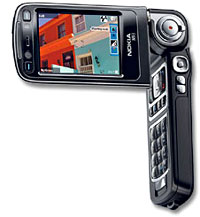 Modestly billed by Nokia as the “ultimate mobile device for spontaneous video recording,” the N93 features a 3.2 megapixel camera with Carl Zeiss optics, “DVD-like” video capture at 30 frames per second, and 3x optical zoom with video stabilisation.
Modestly billed by Nokia as the “ultimate mobile device for spontaneous video recording,” the N93 features a 3.2 megapixel camera with Carl Zeiss optics, “DVD-like” video capture at 30 frames per second, and 3x optical zoom with video stabilisation.
The feature set is mighty impressive, with the N93 offering 802.11b/g Wi-Fi, Bluetooth 2.0, MiniSD slot, video player with streaming support and TV-out.
The onboard music player can keep you rocking to MP3, AAC, AAC+ and WMA, and there’s a FM radio with visual radio for some Terry Wogan on the move.
Sadly, those looking to see the famous wig wobbling about on TV will be disappointed to learn that the there’s no DVB-H tuner onboard.
The Nokia N93 is expected to be available in July 2006.
Nokia waves around the wedge. Celebs flock for a slice.
Nokia have pushed the boat out on promoting these new phones, somehow persuading actor/director Gary Oldman to shoot a short film using the N93 as part of their “pioneering new mobile video initiative”, the Nokia Nseries Studio.
Apparently, Oldman has become part of an “international cast of creative visionaries who are shooting mobile movies for the Nokia Nseries,” with the results being posted up at www.nokia.com/nseries/studio
Come the summer, Nokia are going to open up the site so mere mortals craving to achieve ‘creative visionary’ status can slap up their own movies.
 We’re getting very excited by what we’ve seen of mobiBLU’s new ultra, ultra-slim US2 media player.
We’re getting very excited by what we’ve seen of mobiBLU’s new ultra, ultra-slim US2 media player. 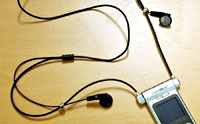 Similarly, we’ve no details about the specifics of the advertised “Audio, Video, Photo support,” but we can guess that it plays back MPEG4 files and can display JPEGs.
Similarly, we’ve no details about the specifics of the advertised “Audio, Video, Photo support,” but we can guess that it plays back MPEG4 files and can display JPEGs.  LG Electronics has rolled up its beefy sleeves, raised its fists and shouted, “Come oooonnn!!!! Let’s be ‘aving you!” to the electronics world, declaring its intent to more than double its share of the world’s top products by 2010.
LG Electronics has rolled up its beefy sleeves, raised its fists and shouted, “Come oooonnn!!!! Let’s be ‘aving you!” to the electronics world, declaring its intent to more than double its share of the world’s top products by 2010.  With a direct hit on the spittoon, he continued, “By substantially increasing the number of flagship goods through our technological prowess, we aim to evolve into a bona fide powerhouse.’
With a direct hit on the spittoon, he continued, “By substantially increasing the number of flagship goods through our technological prowess, we aim to evolve into a bona fide powerhouse.’  Pointing aggressively, Myung-wo says he wants the global market for plasma display panel (PDP) modules, PDP TVs, liquid crystal display (LCD) TVs, side-by-side refrigerators, built-in air conditioners and drum washers to be pwned by LG.
Pointing aggressively, Myung-wo says he wants the global market for plasma display panel (PDP) modules, PDP TVs, liquid crystal display (LCD) TVs, side-by-side refrigerators, built-in air conditioners and drum washers to be pwned by LG.  Similarly, when it comes to domestic air conditioners, LG rules the roost, and the company is now wrestling for the crown of King of Flat-Panel Displays, knocking out 730,000 plasma units last year to nudge past market leaders Samsung SDI.
Similarly, when it comes to domestic air conditioners, LG rules the roost, and the company is now wrestling for the crown of King of Flat-Panel Displays, knocking out 730,000 plasma units last year to nudge past market leaders Samsung SDI.  Microsoft has slipped out a pair of branded Webcams designed to offer tight integration with their hideously popular Messenger service.
Microsoft has slipped out a pair of branded Webcams designed to offer tight integration with their hideously popular Messenger service.  Both cams also come with built in mics, a wide angle lens to let social butterflies fit their vast armies of chums in frame and built-in cheesy video effects like falling snowflakes or twinkling stars.
Both cams also come with built in mics, a wide angle lens to let social butterflies fit their vast armies of chums in frame and built-in cheesy video effects like falling snowflakes or twinkling stars.  Here’s Microsoft’s Consumer Productivity Experiences Executive Vice President (who dreams up these job titles?) Tom Gibbons to explain how LifeCams are part of a new initiative by his company to tie in hardware products to Windows Live services.
Here’s Microsoft’s Consumer Productivity Experiences Executive Vice President (who dreams up these job titles?) Tom Gibbons to explain how LifeCams are part of a new initiative by his company to tie in hardware products to Windows Live services. 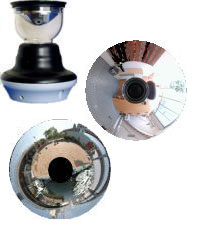 Japanese manufacturers Suekage are hoping that their new SOIOS 55-Cam 360’s unique ability to provide panoramic viewing angles and then relay them to 3G phones may make them a hit in the home security market.
Japanese manufacturers Suekage are hoping that their new SOIOS 55-Cam 360’s unique ability to provide panoramic viewing angles and then relay them to 3G phones may make them a hit in the home security market.  Well, that’s what their blurb said, and we’re not in the mood to get out a protractor and argue the toss, but that basic principle is: big curvy mirror = 360 coverage.
Well, that’s what their blurb said, and we’re not in the mood to get out a protractor and argue the toss, but that basic principle is: big curvy mirror = 360 coverage. 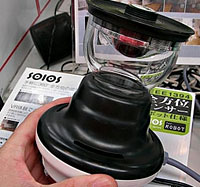 The advantage of this system is that the webcam’s 360 degree all-seeing eye does away with the need for expensive motorised systems
The advantage of this system is that the webcam’s 360 degree all-seeing eye does away with the need for expensive motorised systems 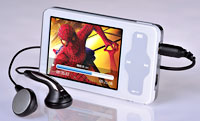 After consulting the well thumbed iPod design book, Chinese electronics manufacturers Meizu have rolled out their new Meizu Mini, a truly Lilliputian Personal Media Player.
After consulting the well thumbed iPod design book, Chinese electronics manufacturers Meizu have rolled out their new Meizu Mini, a truly Lilliputian Personal Media Player. 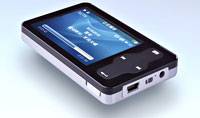 Other onboard gizmos include Synchronized Lyric Display, E-book, alarm clock, calculator, calendar and some (unspecified) games.
Other onboard gizmos include Synchronized Lyric Display, E-book, alarm clock, calculator, calendar and some (unspecified) games.  So far we’ve only seen Chinese language screen shots but the interface seems crisp and slick enough to us.
So far we’ve only seen Chinese language screen shots but the interface seems crisp and slick enough to us.  The player comes with a white or black finish and a metal back just like the – yep, you’ve guessed it – iPod.
The player comes with a white or black finish and a metal back just like the – yep, you’ve guessed it – iPod. 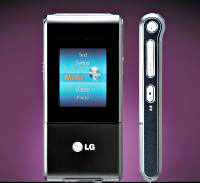 It may not have the swish designer lines of the iPod and the name may roll off the tongue as smoothly as a mouth full of dry nuts, but LG Electronics new MFJM53 MP3 player looks more than a bit useful.
It may not have the swish designer lines of the iPod and the name may roll off the tongue as smoothly as a mouth full of dry nuts, but LG Electronics new MFJM53 MP3 player looks more than a bit useful. 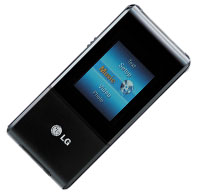 Although we like the look of this fella – the feature set particularly impresses – the lack of a scroll/clickwheel is going to seriously hamper its ability to challenge the dominance of the uber-iPod.
Although we like the look of this fella – the feature set particularly impresses – the lack of a scroll/clickwheel is going to seriously hamper its ability to challenge the dominance of the uber-iPod.  The dome-headed boffins at Nokia have triumphantly put their multiple pens back in their white coat pockets as the new Nokia N73 and N93 phones roll out on the product slipway.
The dome-headed boffins at Nokia have triumphantly put their multiple pens back in their white coat pockets as the new Nokia N73 and N93 phones roll out on the product slipway.  Being Brits, we refuse to describe mobiles as having a ‘candybar’ form factor, so how about we call the N73, ‘Amazin’ Raisin Bar’ shaped?
Being Brits, we refuse to describe mobiles as having a ‘candybar’ form factor, so how about we call the N73, ‘Amazin’ Raisin Bar’ shaped?  Rounding off the man-sized feature set is Bluetooth 2.0, a music player supporting MP3, AAC, AAC+ and WMA, video player with streaming support, FM radio with visual radio and a set of built-in pixie-sized 3D stereo speakers.
Rounding off the man-sized feature set is Bluetooth 2.0, a music player supporting MP3, AAC, AAC+ and WMA, video player with streaming support, FM radio with visual radio and a set of built-in pixie-sized 3D stereo speakers.  Modestly billed by Nokia as the “ultimate mobile device for spontaneous video recording,” the N93 features a 3.2 megapixel camera with Carl Zeiss optics, “DVD-like” video capture at 30 frames per second, and 3x optical zoom with video stabilisation.
Modestly billed by Nokia as the “ultimate mobile device for spontaneous video recording,” the N93 features a 3.2 megapixel camera with Carl Zeiss optics, “DVD-like” video capture at 30 frames per second, and 3x optical zoom with video stabilisation. 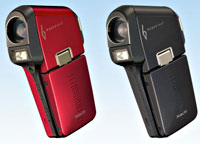 Sanyo have just launched what it’s claiming is the world’s smallest, thinnest and lightest solid state digital camcorder, the Xacti C6.
Sanyo have just launched what it’s claiming is the world’s smallest, thinnest and lightest solid state digital camcorder, the Xacti C6. 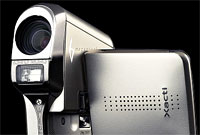 Saving space by recording straight to a SD card instead of using conventional tape, recordable DVD or hard disk, the Sanyo can grab an hour of VGA resolution (640?480 pixels) video at 30 frames-per-second on a 1 GB card using the “TV-HQ” mode (MPEG-4 bit rate: 2 Mbps).
Saving space by recording straight to a SD card instead of using conventional tape, recordable DVD or hard disk, the Sanyo can grab an hour of VGA resolution (640?480 pixels) video at 30 frames-per-second on a 1 GB card using the “TV-HQ” mode (MPEG-4 bit rate: 2 Mbps). 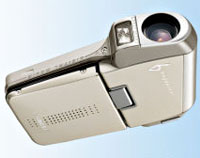 There’s also a 5x optical zoom, 12x digital zoom and a Digital Image Stabiliser for correcting any wobbles, with the CCD sensor using 9-pixel mixing technology to record brighter and clearer video in low-light situations.
There’s also a 5x optical zoom, 12x digital zoom and a Digital Image Stabiliser for correcting any wobbles, with the CCD sensor using 9-pixel mixing technology to record brighter and clearer video in low-light situations. 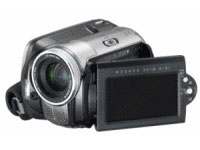 JVC has unveiled the flagship model to its extensive range of Everio hard drive camcorders, the GZ-MG77.
JVC has unveiled the flagship model to its extensive range of Everio hard drive camcorders, the GZ-MG77.  In the highest resolution mode, Ultra Fine, users can record 7 hours and 10 minutes of video at 9 Mbps.
In the highest resolution mode, Ultra Fine, users can record 7 hours and 10 minutes of video at 9 Mbps.  Video can be recorded in both standard and widescreen aspect formats, with an option to record stills.
Video can be recorded in both standard and widescreen aspect formats, with an option to record stills.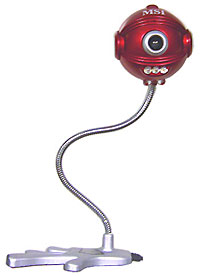 When we saw MSI’s feature packed StarCam 370i knocking out for a mere £15 online ($26, €22), we thought it would make an ideal replacement for our elderly (and somewhat battle-weary) Sony cam, currently gazing out over the delights of Brixton.
When we saw MSI’s feature packed StarCam 370i knocking out for a mere £15 online ($26, €22), we thought it would make an ideal replacement for our elderly (and somewhat battle-weary) Sony cam, currently gazing out over the delights of Brixton. A rudimentary software control panel lets users fiddle about with image/video parameters (gamma, brightness, contrast etc), and budding Jean-Luc Godard’s can select the black and white option for arty scenes.
A rudimentary software control panel lets users fiddle about with image/video parameters (gamma, brightness, contrast etc), and budding Jean-Luc Godard’s can select the black and white option for arty scenes. The cam also features a built in microphone which was, as you might expect, fairly basic and lo-fi, but good enough for Internet calls.
The cam also features a built in microphone which was, as you might expect, fairly basic and lo-fi, but good enough for Internet calls.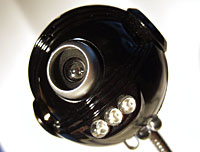 We can, however, recommend it for anyone looking for a basic, cheap as chips Webcam for video chats with friends and relatives.
We can, however, recommend it for anyone looking for a basic, cheap as chips Webcam for video chats with friends and relatives.